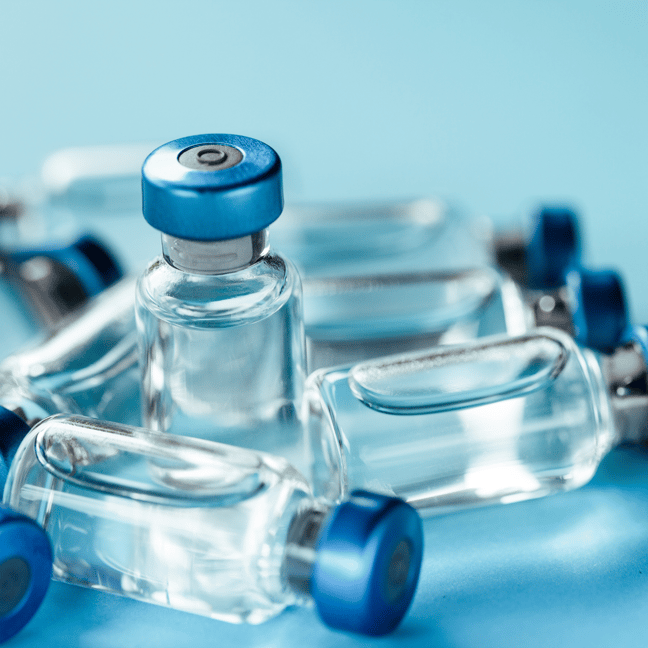Share this
Crimping Vials : selecting the right closure system for your pharmaceutical project
by Ewan on Apr 11, 2024 3:32:32 PM
The challenge of preserving the safety, integrity, and efficacy of pharmaceutical products is ever-present in the pharmaceutical industry. Crimping vials, a cornerstone of this packaging ecosystem, are designed to meet these challenges head-on. However, selecting the appropriate crimping vial closure system—a decision that can significantly impact a product's success or failure—is fraught with complexity and potential pitfalls. This choice affects not only the physical protection of the medication but also its stability, user safety, and compliance with rigorous regulatory standards.
The stakes are high. A poorly chosen closure system can lead to contamination, product recalls, and, most gravely, endanger patient health. For production managers, the pressure to navigate these waters successfully, balancing the demands of pharmaceutical formulations with the operational realities of manufacturing, is a substantial burden.
Acknowledging these challenges, this article is crafted to guide production managers through the labyrinth of selecting an apt crimping vial closure system tailored to their specific projects. It's a roadmap aimed at navigating the pain points associated with this critical aspect of pharmaceutical packaging—addressing the consequences of incompatibility, regulatory non-compliance, and inefficiencies that can escalate costs and compromise patient safety.
This guide also highlights the value of informed packaging decisions. These decisions, as we will explore, are not just about meeting today's needs but anticipating tomorrow's challenges, ensuring that pharmaceutical products are delivered to patients in the safest, most effective manner possible.
Understanding Crimping Vials
The Importance of Crimping Vials in Pharmaceutical Packaging
Crimping vials are a cornerstone of pharmaceutical packaging, offering a secure method to seal medication containers. Comprising three main components - the vial, the cap, and the crimp - these packaging solutions are designed to protect and preserve the contents they hold. The vial acts as the primary container, typically made from glass or plastic, which houses the pharmaceutical product. The cap, fitted onto the vial's opening, can be made from various materials including aluminum or plastic, and is secured in place by the crimp, a metal or plastic ring that tightly seals the cap to the vial, ensuring airtight closure.
Crimping vials safeguard product integrity, ensuring safety, and maintaining compliance with regulatory standards. Their tight seal prevents contamination and leakage, thereby preserving the efficacy and shelf life of the pharmaceutical product within. This sealing mechanism is important for the stability of sensitive formulations, offering protection against environmental factors such as air, light, and moisture. Moreover, the use of crimping vials is instrumental in meeting strict regulatory requirements, providing a reliable packaging solution that supports the health and safety of end consumers.

Types of Crimping Vials
- Glass vs. Plastic Vials: The choice between glass and plastic vials is influenced by various factors including material properties, the nature of the pharmaceutical product, and required shelf life. Glass vials, renowned for their chemical inertness and excellent barrier properties, are the preferred choice for many pharmaceuticals, especially those sensitive to contamination or chemical interaction. Plastic vials, on the other hand, offer advantages in terms of durability, lighter weight, and lower risk of breakage, making them suitable for certain applications where these attributes are prioritized.
Despite these differences, both glass and plastic vials are designed to work efficiently with crimping systems, ensuring that the choice of material does not compromise the integrity of the seal. It is important to note that while the packaging components are essential for product protection, they are not regulated by entities such as the FDA or European EMA. This highlights that the regulatory focus is primarily on direct contact materials, though the choice of closure system remains critical for overall product safety and efficacy.
- Cap Materials and Types: Caps for crimping vials are available in a variety of materials and designs, each offering distinct advantages. Aluminum caps are widely used for their excellent seal integrity and protection against environmental contaminants. They are often employed in conjunction with a rubber or plastic stopper, under the cap, to ensure airtight sealing and to facilitate easy access to the vial contents when needed.
Plastic caps, including flip-off and tear-off types, provide convenient options for end-users. Flip-off caps feature a plastic top that can be removed to expose the underlying stopper, allowing for easy access with a syringe without removing the entire cap. Tear-off caps, meanwhile, are designed to be completely removed, providing full access to the vial's contents. These types are chosen based on the specific needs of the pharmaceutical product, considering factors such as ease of use, tamper evidence, and the method of administration.
Selecting the Right Closure System
Considerations for Selection
- Product-Specific Requirements: The nature of the pharmaceutical product significantly influences the choice of crimping vial and closure system. Liquid formulations require airtight seals to prevent leakage and contamination, while powders need moisture-resistant closures to maintain product integrity. The sensitivity of the product to light or air can necessitate the use of colored glass vials or specific cap materials that offer additional protection. Understanding these nuances ensures that the selected packaging aligns with the product's unique needs, safeguarding its efficacy from production through to end use.
- Regulatory Compliance: Compliance with pharmacopeial standards is important. This includes ensuring that the selected closure systems do not interact adversely with the product or compromise its quality. Additionally, the packaging must often include child-resistant and tamper-evident features to meet safety regulations, protecting consumers and maintaining trust in pharmaceutical brands.
- Compatibility with Production Equipment: The efficiency of the pharmaceutical packaging process is heavily dependent on the compatibility of crimping vials and closure systems with existing production line equipment. Selecting systems that integrate seamlessly minimizes the need for new investments in machinery and avoids production delays. This aspect underscores the importance of working with packaging solution providers that understand the technical specifications and operational capacities of pharmaceutical production facilities.
Evaluating Closure System Options
- Seal Integrity and Protection: Different closure systems offer varying levels of seal integrity and protection. High-quality seals are imperative to prevent contamination, leakage, and degradation caused by environmental factors. The selection process should therefore include rigorous evaluation of the closure system's ability to maintain an airtight seal over the product's intended shelf life. This evaluation can involve testing for compatibility with the product's formulation and assessing the resilience of the seal under various storage and transport conditions.
- Ease of Use and Accessibility: The closure system's design impacts the end-user experience, particularly in terms of ease of opening and the possibility of resealing the vial if needed. Systems that are difficult to open can frustrate patients and caregivers, potentially affecting compliance with treatment regimens. Conversely, closures that are too easy to open may compromise safety, especially in households with children. Balancing these considerations is essential in selecting a closure system that facilitates accessibility while ensuring safety.
- Cost Considerations: Analyzing the cost implications of different crimping vial closure systems involves weighing upfront costs against the long-term benefits in product protection, regulatory compliance, and consumer satisfaction. While more sophisticated closure systems may incur higher initial costs, their contribution to maintaining product integrity and safety can result in reduced liability and enhanced brand reputation, ultimately delivering greater value over the product's lifecycle.
Best Practices in Crimping Vial Selection
and Use
Implementing a Selection Process
- Conducting Risk Assessments: A comprehensive risk assessment is paramount in the initial stages of selecting crimping vials and closure systems. This involves evaluating potential risks associated with different closure systems in relation to the specific pharmaceutical product they will contain. Factors to consider include the product's compatibility with the closure materials, the potential for chemical interactions, and the suitability of the closure system under various storage conditions. Additionally, regulatory requirements, even in the absence of direct regulations on caps, and production capabilities must be considered to ensure that the chosen system does not compromise product integrity or safety. Effective risk assessment helps in identifying and mitigating potential issues early in the selection process, facilitating a smoother transition to production.
- Pilot Testing and Validation: Before full-scale implementation, pilot testing of selected crimping vials and closure systems with the actual pharmaceutical product is important. This step allows for the validation of the system's performance, ensuring that it meets all specified requirements for safety, efficacy, and compatibility with production processes. Pilot testing should simulate real-world conditions as closely as possible to identify any potential issues that might not be evident in theoretical assessments. The results from these tests are critical for making informed decisions on the final selection of crimping vials and closure systems.
Ensuring Quality and Compliance
- Quality Control Measures: To ensure that crimping vials and closure systems consistently meet the required standards, stringent quality control measures must be implemented. This includes regular visual inspections to detect any defects or inconsistencies, leak testing to ensure the integrity of the seal, and compatibility testing to confirm that there are no adverse reactions between the vial/closure system and the pharmaceutical product. These measures are essential for maintaining high standards of quality and safety throughout the lifecycle of the product.
- Documentation and Traceability: Maintaining comprehensive documentation and traceability for crimping vials and closure systems is important for supporting regulatory compliance and facilitating issue resolution. This documentation should include details of the selection process, quality control tests, and any issues identified and addressed during production. Traceability ensures that any components can be tracked back to their source, allowing for swift action if any quality or safety concerns arise. This level of documentation is not only a regulatory requirement but also a best practice that enhances the credibility and reliability of the pharmaceutical product.
Conclusion
In the quest to ensure the safety, efficacy, and integrity of pharmaceutical products, the selection of the right crimping vial closure system emerges as a pivotal decision for production managers. This article has traversed the essential considerations necessary for making an informed choice, emphasizing the balance between product requirements, regulatory compliance, and cost-effectiveness.
Recap of Key Points:
- Product-Specific Requirements: The nature of the pharmaceutical product dictates the choice of crimping vial and closure system, with considerations for material compatibility, protection against environmental factors, and the suitability for the product's physical form (liquid, powder, etc.).
- Regulatory Compliance: Despite the absence of direct regulations regarding closure systems by agencies like the FDA or EMA, ensuring that packaging solutions meet general pharmacopeial standards and contribute to overall product safety and integrity remains important.
- Compatibility with Production Equipment: The efficiency of the packaging process hinges on the seamless integration of crimping vials and closure systems with existing production lines, minimizing the need for costly adjustments or equipment upgrades.
- Evaluating Closure System Options: A thorough assessment of seal integrity, ease of use, and cost considerations ensures that the chosen system aligns with the long-term objectives of product protection, regulatory adherence, and consumer satisfaction.
Production managers are strongly encouraged to consult with packaging experts and suppliers, such as EMA Pharma, renowned for their expertise and comprehensive solutions tailored to the pharmaceutical sector. Engaging with professionals ensures access to the latest innovations, insights, and technologies in pharmaceutical packaging, enabling production managers to make decisions that are not only informed but also strategically aligned with their specific project needs and industry best practices.
EMA Pharma, with its rich history of providing high-quality packaging solutions, stands ready to assist production managers in identifying the optimal crimping vial closure systems for their projects. By leveraging EMA Pharma's expertise, clients can navigate the selection process more effectively, ensuring that their pharmaceutical products are packaged in a manner that upholds the highest standards of safety, efficacy, and patient satisfaction.

No Comments Yet
Let us know what you think